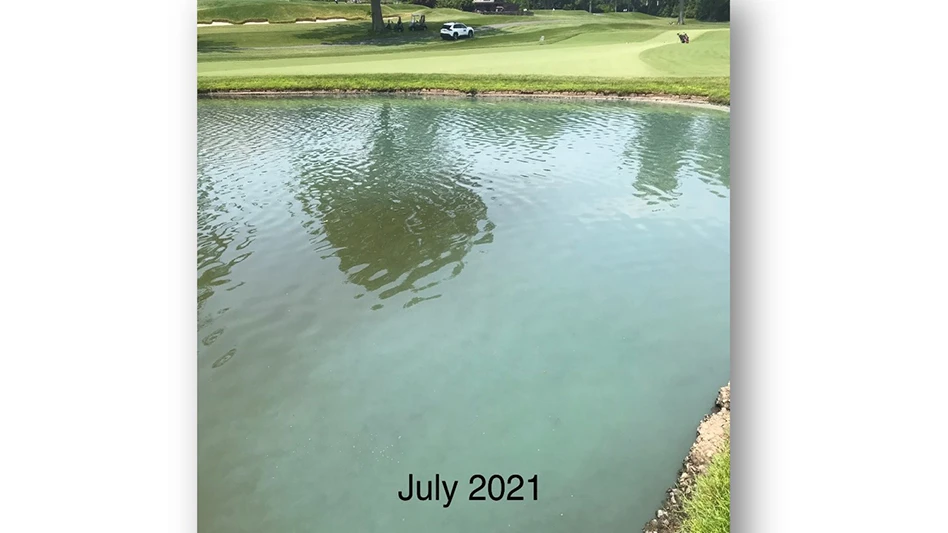


Odds are good that when A.W. Tillinghast carved out one of the more prominent ponds in golf — the waterway that guards the green of The Famous Fourth on the Lower Course at Baltusrol Golf Club — he never considered phosphorus. Or algal blooms, which thrive off excess phosphorus. Or probably anything other than a perfect hazard.
Same goes for Robert Trent Jones, who replaced a log wall with the more familiar rock wall inches from the green when he was commissioned to update and lengthen the layouts. There were enough structural specifics to consider that aquatic science was not top of mind.
More than seven decades after Jones renovated the course — and nearly a century after Tillinghast originally designed it — Jeff Reggio received precious little education about ponds and water health, either.
“In school, you’re constantly taught the science behind the turf and how to manage a golf course,” says Reggio, the Upper Course superintendent at Baltusrol since January 2019. “Ponds are not a topic really discussed.”
Reggio learned lots about turf during his four years at Penn State, but he has been expanding his aquatic knowledge ever since, sitting in on seminars and education sessions whenever he attends a conference.

“Ponds are the hardest thing,” he says. “It feels like you’re good one day, then you come in the next day and it’s just, What just happened?”
Which is why Reggio pores over potential solutions for every pond problem. The pond on The Famous Fourth is a focal point for the course — but thanks to increased rainfall the last few seasons, its surface has been covered during recent summers with algal blooms.
“We start off so clean and then we get to late July when it’s hot and a lot of the rainfall releases phosphorus from the soil,” Reggio says. “When it starts to get wet, that’s when we see that explosion. We’re trying to get away from those swings of the water quality and its aesthetics.”
Reggio talked with SePRO technical specialist Joe Lynch, who works throughout the Northeast and who recommended EutroSORB, which is designed to filter out phosphorus and improve water quality. Reggio and Lynch laid down half a dozen filters in early August and flipped them three weeks later. The water quality and clarity is better than it has been in years.
“With a lot of systems, the key management objective is aesthetics,” says Dr. West Bishop, algae scientist and water quality research manager at SePRO, and part of the EutroSORB development team. “You don’t want it to smell bad, you don’t want the algal bloom to crash or cause fishkills. Some algae can be toxic, too, and you don’t want anything toxic in there, but the overall quality of the water is important.”
Although still gathering field data, anecdotal reports Bishop received from across the industry are encouraging:
I didn’t have to use as much algaecide because we didn’t have as many blooms. ... I had increased clarity and more usable water. ... This was easier to manage.
“We’re trying to solve key problems in the environment and we see this as a neat strategic way to do that,” Bishop says. “We see a lot of golf courses have shifted to proactive management techniques, and that’s what we’re trying to do in the water.”
Count Reggio among those who provided encouraging updates: He plans to install at least 18 filters in each of Baltusrol’s four major ponds — at staggered dates to maximize phosphorus filtration efficiency.
“The great thing is that it’s plug and play,” Reggio says. “You don’t have to worry about the labor aspect and constantly go out to retreat a pond. For some golf courses, this could be the perfect fit. I was very happy with the final product.” ?

Explore the February 2022 Issue
Check out more from this issue and find your next story to read.
Latest from Golf Course Industry
- Golf Construction Conversations: Reed Anderson
- ’Twas the Night Before Christmas (on turf)
- Twas the Night Before Christmas (the turf version audio)
- Advanced Turf Solutions and The Aquatrols Company release soil surfactant
- Heritage Golf Group acquires North Carolina courses
- Editor’s notebook: Green Start Academy 2024
- USGA focuses on inclusion, sustainability in 2024
- Greens with Envy 65: Carolina on our mind





